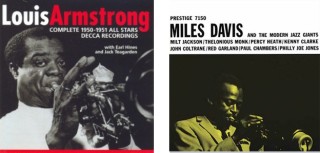- Manufacturer: Yamaha Corporation
- Designer: Toshihide Suzuki
- Dimensions: 16 × 55 × 13
- www.yamaha.com
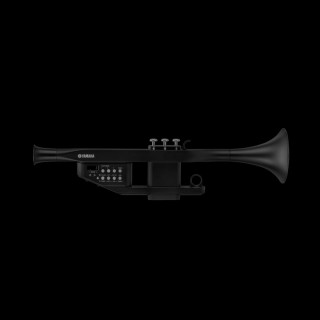
Index
- Design This is the digital way to learn the trumpet, but also to share and save your MIDI-produced songs with your computer, The EZ-TP trumpet is designed t
- About Synthesizers A synthesizer (or synthesiser) is an electronic instrument that is capable of producing a variety of sounds by generating and combining signals of dif
- EWIs and EVIs EWI (an acronym for Electric Wind Instrument) is the name of AKAI's line of wind controllers, an electronic musical instrument invented by Nyle Steine
- Similar Products Kazoo trumpet A kazoo is a tube-formed, American musical instrument, with both ends of the tube uncovered. One end of the tube is flattened, while the
- Silent Instruments Yamaha has introduced a family of new and re-designed silent instruments that offer the flexibility of silent play to string and brass musicians. With
- The Trumpet The instrument The trumpet is the musical instrument with the highest register in the brass family. Trumpets are among the oldest musical instruments,
This is the digital way to learn the trumpet, but also to share and save your MIDI-produced songs with your computer,
The EZ-TP trumpet is designed to react to your humming, not mouth positions, so you can effectively play the instrument by making the proper tones yourself. To learn fingering, the Lighted Teaching System teaches the proper way.
You can download songs online and load them onto the EZ-TP with the supplied MIDI cable.
During development of the EZ-TP™, Yamaha sought ideas and opinions from the general public through its own internet-based music portal sites and the make-to-order website "Tanomikomu". Many of the suggestions received for design, materials, and sounds were used in the final product.
A synthesizer (or synthesiser) is an electronic instrument that is capable of producing a variety of sounds by generating and combining signals of different frequencies. Synthesizers create electrical signals, rather than direct acoustic sounds, which are then played through a loudspeaker or set of headphones.
The synthesizer has had a large impact on modern music over the past forty years. The first significant influence of the instrument came during the 1970s and 1980s. Wendy Carlos's Switched-On Bach (1968), recorded using Moog synthesizers, influenced numerous musicians of that era, and is one of the most popular classical music recordings ever made. During the late 1960s, hundreds of other popular recordings used Moog synthesizers. The Moog synthesizer spawned a subculture of record producers who made novelty "Moog" recordings, using synthesizers to create new sounds to draw attention and sales. Musicians such as Richard Wright of Pink Floyd used the Moog and other synthesizers extensively.
This instrument is such a part of modern music, that if we were to take it away, most pop songs would be literally empty. From its early beginnings of generating simple tones, the synth has gone on to recreate full orchestras, drums, guitars, bass, piano, well just about any instrument.
The required subtlety of synthesizers
A synthesizer's ability to replace or surpass conventional musical instruments as art forms will rely heavily on how well they are able to translate, in a natural fashion, the player's expression into sound. Traditional acoustic instruments have been evolving now for hundreds of years, especially in the case of the brass and woodwind families. The improvements that have been made in this last 25 year period of technological explosion have done little to better the instruments made 25 to 100 years ago as regards fundamental design."
That's a short extract from a piece written by Bill Bernardi [designer of] the Lyricon - the first commercially available wind-controlled electronic instrument. The date? July 21st, 1972. Before drum synths, polyphonic synths, or velocity-sensitive keyboards , Bill Bernardi and Roger Noble spent years researching the design and construction of musical instruments prior to developing the Lyricon - the first commercially available wind-controlled electronic instrument.
Bill again:
"We were awed by the incredible degree of skill and craftsmanship that was in evidence during the days of Antoine (Adolphe) Sax and Theobald Boehm (designer of the Boehm flute and fingering systems). They concluded that the instrument itself wasn't half as important as the total 'musical system' comprising player and hardware closely linked together. "An acoustic instrument is basically a highly sensitive and articulate control system coupled to a human player who is capable of transmitting highly subtle degrees of control into the acoustic sound generating system. The awesome complexity lies . . . with the ability of the instrument to interface and relate to the player. " These concepts have begun to concern the mainstream instrument manufacturers. They have invested much time and effort developing weighted, touch-sensitive, piano-style keyboards; better and more comfortable electronic drum pads; and guitar synths that attempt to wail like a Les Paul [electric guitar].
Midi
Midi is an industry-standard protocol defined in 1982 that enables electronic musical instruments such as keyboard controllers, computers and other electronic equipment to communicate, control, and synchronize with each other. MIDI allows computers, synthesizers, MIDI controllers, sound cards, samplers and drum machines to control one another, and to exchange system
data. MIDI does not transmit an audio signal or media — it transmits "event messages" such as the pitch and intensity of musical notes to play, control signals for parameters such as volume, vibrato and panning, cues, and clock signals to set the tempo. As an electronic protocol, it is notable for its widespread adoption throughout the music industry.
EWI (an acronym for Electric Wind Instrument) is the name of AKAI's line of wind controllers, an electronic musical instrument invented by Nyle Steiner. The early models consisted of two parts: a wind controller and a synthesizer.
The EWI and EVI [Electronic Valve Instrument] wind controllers are extremely versatile and expressive instruments. All of the EWIs and EVI use your breath, sax or trumpet-like fingerings, bite and thumbs to control the instrument.
The First EWI
The Lyricon is an electronic wind instrument, the first Wind controller to be constructed.
Invented by Bill Bernardi (and co-engineered by Roger Noble and with former Lyricon performer Chuck Greenberg, it was manufactured by a company called Computone Inc in Massachusetts. The Lyricon was available in 2 different designs, the first one being somewhat silver and resembling a soprano saxophone and the latter, black and resembling an alto clarinet. [It] used a bass clarinet mouthpiece, with a sprung metal sensor on the (non-vibrating) reed that detected lip pressure. Wind pressure was detected by a diaphragm, which moved and changed the light output from an LED, which was in turn sensed by a photocell to give dynamic control.
EWI Players
Since the 1980s the EWI has been well known to fans of the Japanese Fusion (J-Fusion) band T-SQUARE as a lead instrument. All three of the band's saxophonists - Takeshi Itoh (1978 - Current), Takahiro Miyazaki (1998 - 2000) and the aforementioned Masato Honda (1990 - 1998) - double on EWI. T-SQUARE has included 2 or 3 new compositions for EWI on each of their albums. They began using the Lyricon in 1980, then upgraded to the Yamaha WX-7 in 1987, then upgraded again to the AKAI EWI in 1990.
Before recent times, the EWI was particularly foreign to the U.S. population, mainly seen in Japan. But the EWI is slowly becoming more popular in the United States. The EWI has recently gained recognition in indie rock circles thanks to the Seattle-based band Heatwarmer, featuring EWI virtuoso Andrew Swanson. The band recently appeared on Portland radio station KBOO, discussing their inclusion of the instrument at length. The EWI has also been heard on select jazz radio stations as of late. Even ethnic musicians, like Catalan Xufu [1], are noted for playing the EWI 4000S.
Kazoo trumpet
A kazoo is a tube-formed, American musical instrument, with both ends of
the tube uncovered.
One end of the tube is flattened, while the other end of the tube has a
small circular opening.
Around two thirds down the instrument there is another circular hole.
This hole leads to a small chamber, where a wax-membrane is situated.
The membrane, which is fixed around the edges by a circular
cylinder-ring, is free to oscillate.
A kazoo may be made out of plastic or metal and can have all sorts of
different shapes.
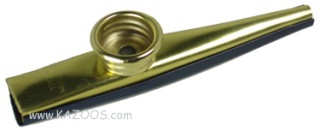
How to play the kazoo
The whole idea behind the instrument is, that a kazoo player by singing
or speaking through the instrument induces an air current which makes
the membrane vibrate and thus creates a summing, "nasal" sound.
By wholly or partially covering up the membrane hole a great diversity
of sounds are created.
The membrane is the key point of the kazoo. This membrane gives the
kazoo its distinction from the "horn-section-instruments". The kazoo
should be viewed as a singing-drum.
Therefore it is of no use to simply blow through a kazoo, which is a
common mistake among first time kazoo-users.
Further it is not recommended to make a hole in the membrane, since this
ruins the instrument, and shows ones lack of understanding the
physics of the kazoo.
The ancient ancestors of the kazoo:
The kazoo is categorised among the type of instruments known as the
"mirlitons".
This group of instruments are characterised by having a vibrating
membrane.
It is believed that the kazoos closest relative is the African version of
a mirliton: the horn-mirliton. The building materials of the
horn-militon were of a more primitive nature. The tube was made out of
the horn of a cow and the membrane consisted of the egg-shells of
spiders.
The different disguises of the kazoo
The looks of a kazoo can vary a lot. Depending on the size of the membrane hole
and the shape of the kazoo all sorts of musical instruments can be imitated.
The Soprano Kazoo- the size of a standard kazoo, can bring out the highest pitch, flute.
The Alto Kazoo- 15 cm, imitating the sound of a clarinet and a trumpet.
The Tenor kazoo- 30 cm, saxophon.
The Bariton Kazoo- 46cm, french horn og jagdhorn.
The Kaboom Kazoo- 90cm, a membran diameter of 12,5cm, tuba.
Eigenharp from Eigenlabs
After eight years in the making, the most revolutionary new musical instrument of the last 60 years has arrived. Designed specifically for live performance, it is simply the most expressive electronic musical instrument ever made.
The ultra-versatile Pico is simple to use and anyone can play it. Light and portable, it packs a powerhouse of features. Use it to play solo, play and record loops, change scale and key, transpose, alter tempo, program beats, create arrangements, switch and layer multiple sounds, all while playing live. It's ideal as a solo instrument or for playing in a band.
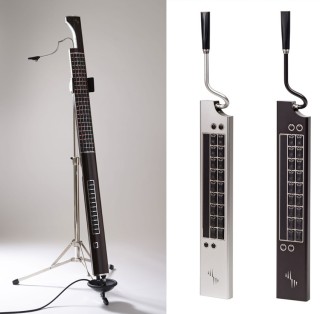
Yamaha has introduced a family of new and re-designed silent instruments that offer the flexibility of silent play to string and brass musicians. With the addition of the Silent Viola, it is now possible to have a string quartet composed entirely of silent string instruments.
SV200 Silent Violin
Yamaha SV200
Now, with the inclusion of the viola, the series, which features violin, cello, bass and brass instruments, enables musicians and composers to practice and perform in complete privacy at any hour, using headphones, without compromising their desire for traditional feeling, performance, and sound. The instruments are perfect for every type of artist in any location where silence is necessary — musicians in apartments, students playing at home or in a dorm, and professionals who need to practice on the road.
The same silent mode technology common to all silent instruments makes it possible to play through an amplifier, resulting in a warm, full-bodied tone with exciting new possibilities for live performance. An auxiliary input on the body of the instruments can easily connect to an external CD player or tape machine for practice with pre-recorded material. A second input jack even allows a musician to duet with another silent instrument player. The strikingly stylish silent ensemble allows musicians to enjoy spacious reverb, as well as the sonic richness and tone of a concert quality instrument, while creating very little external sound.
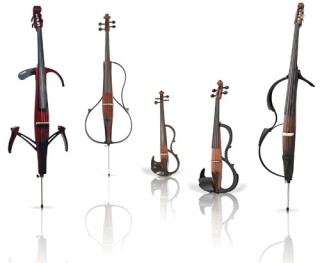
The instrument
The trumpet is the musical instrument with the highest register in the brass family. Trumpets are among the oldest musical instruments,[1] dating back to at least 1500 BC. They are constructed of brass tubing bent twice into an oblong shape, and are played by blowing air through closed lips, producing a "buzzing" sound which starts a standing wave vibration in the air column inside the trumpet.
There are several types of trumpet; the most common is a transposing instrument pitched in B♭. The predecessors to trumpets did not have valves, but modern trumpets have either three piston valves or three rotary valves. Each valve increases the length of tubing when engaged, thereby lowering the pitch.
The trumpet is used in many forms of music, including classical music and jazz.
The muted instrument
A variety of mutes have been used on brass instruments, all of which either squeeze inside the bell of the instrument, or are hung or clipped to the outside of the bell. These mutes are typically made out of aluminum, brass, or copper metal, but more economical plaster, cardboard, and plastic versions exist. Each material produces a distinctive sound.

Famous players
The trumpet is used in many forms of music, though the most recognised players have been in the jazz field. Louis Armstrong, for example, was well known for his virtuosity with the trumpet. Armstrong's improvisations on his Hot Five and Hot Seven records were daring and sophisticated while also often subtle and melodic. Miles Davis is widely considered one of the most influential musicians of the 20th century. His trumpet playing was distinctive, with a vocal, clear tone that has been imitated by many. The phrasing and sense of space in his solos have been models for generations of jazz musicians.[16] Dizzy Gillespie was a trumpet virtuoso and gifted improviser, building on the style of Roy Eldridge but adding new layers of harmonic complexity. Gillespie had an enormous impact on virtually every subsequent trumpeter, both by the example of his playing and as a mentor to younger musicians. Maynard Ferguson came to prominence playing in Stan Kenton's orchestra, before forming his own band in 1957. He was noted for being able to play accurately in a remarkably high register.
